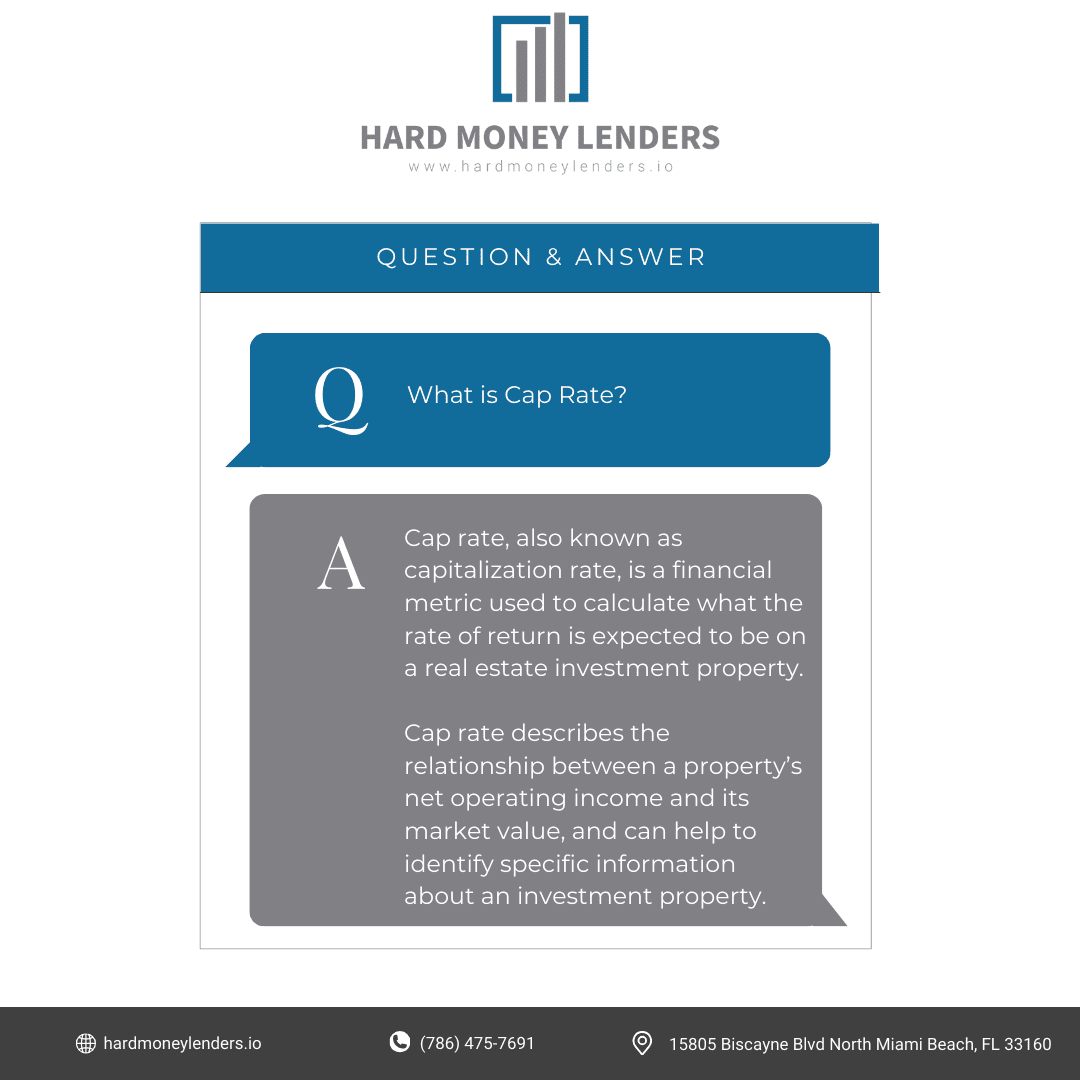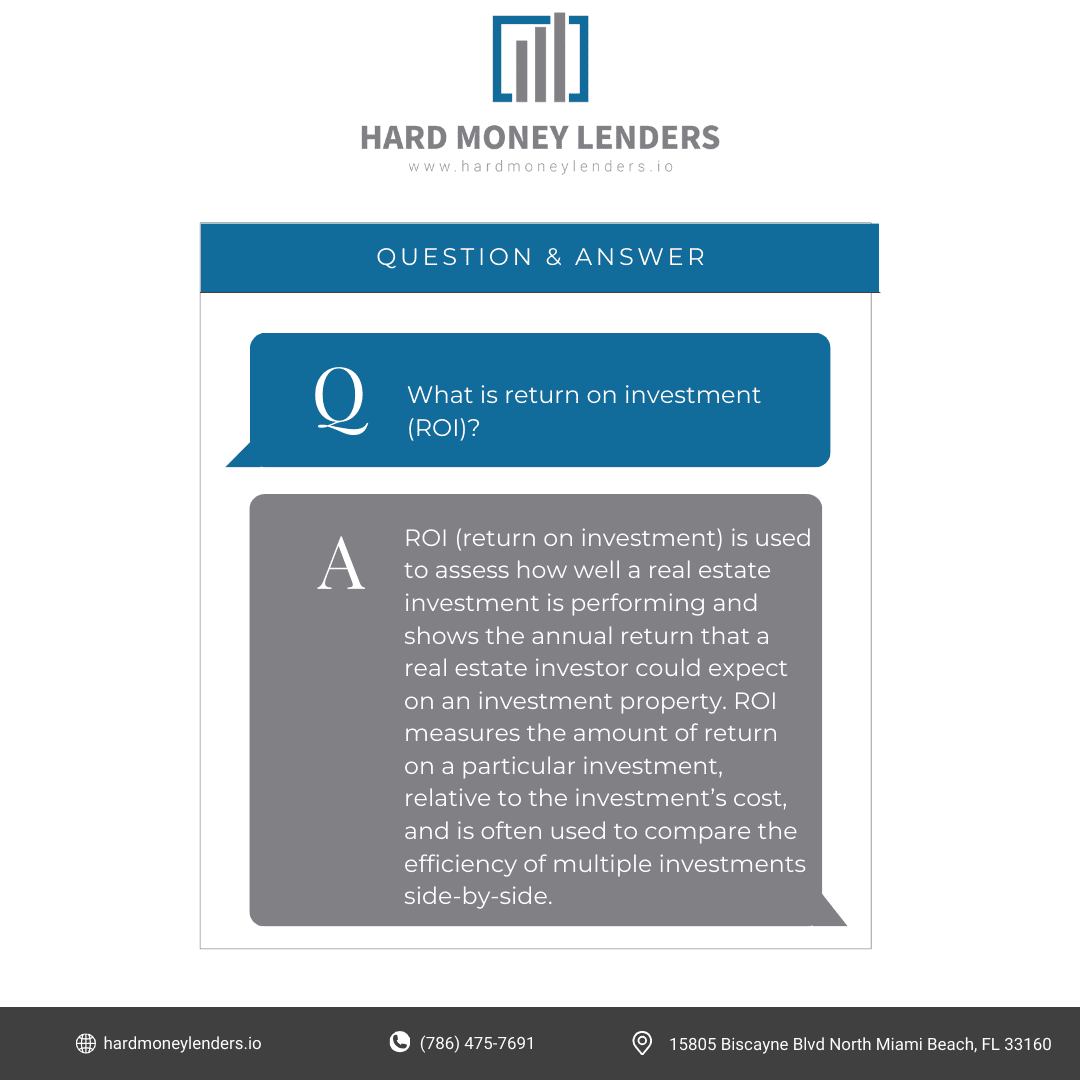What is the Difference Between Cap Rate and ROI?
If you are new to real estate investing, there are many concepts and analytics that are associated with it that may seem confusing at first glance. Many new investors have trouble determining the profitability and performance of their investment properties, which are two factors that should absolutely be considered before committing to a property long-term. Cap rate and return on investment (ROI) are two of the best real estate analysis tools that can be used to help you determine the profitability of your property investments. So what’s the difference between cap rate and return on investment (ROI)? Find out all about the two metrics below.
Net Operating Income and Cash Flow
Before we dive into cap rate and return on investment, there are two terms that you should familiarize yourself with beforehand; net operating income (NOI) and cash flow.
Net operating income (NOI) is the annual cash income generated from an investment property after normal operating expenses have been deducted. NOI does not include principal and interest payments on loans, capital expenditures, depreciation, and amortization. To calculate your NOI, simply subtract your operating expenses from your real estate revenue.
Cash flow is your annual cash income after deducting mortgage expenses from the net operating income. One way to think of cash flow is the amount of money you’re left with at the end of the day after all of your bills are paid.
What is Cap Rate?

Cap rate, also known as capitalization rate, is a financial metric used to calculate what the rate of return is expected to be on a real estate investment property. Cap rate describes the relationship between a property’s net operating income and its market value, and can help to identify specific information about an investment property.
First, cap rate can identify the potential rate of return on a property assuming that it was purchased with cash. Cap rate can also measure the perceived risk associated with a potential rental property. A higher cap rate means that the market identifies more risk and demands higher returns. A lower cap rate means that the market identifies lower risk so they are willing to accept a lower return. Lastly, depending on the inputs in the cap rate calculation, it can also be used to calculate the potential value of a property.
Cap rate is the most useful metric for assessing real estate investments for their profitability and potential return. The cap rate simply represents the yield of a property over a specified period of time assuming the property is purchased with cash.
Formula for Calculating Cap Rate
The formula for cap rate is: Cap Rate = NOI / Property value
For example, say we have a property with a market value of $200,000 and a net operating income of $15,000. To determine the cap rate, we would use the following formula:
$15,000 NOI / $200,000 Property value = 0.075 or 7.5% cap rate
Remember that the cap rate equation is based on annual income, which means that the rate of the same property could differ from year to year.
Let’s say that a rental property wasn’t occupied for six months last year but was fully occupied this year. The cap rate for last year would be significantly lower than this year’s because last year’s NOI was lower due to a high vacancy rate.
You can also use the cap rate equation to determine a property’s market value. If you know the property’s NOI and the market cap rate, you can reverse the formula to find the market value.
$15,000 NOI / 7.5% (.075) cap rate = $200,000 market value
What is ROI?

ROI (return on investment) is used to assess how well a real estate investment is performing and shows the annual return that a real estate investor could expect on an investment property. ROI measures the amount of return on a particular investment, relative to the investment’s cost, and is often used to compare the efficiency of multiple investments side-by-side.
The ROI calculation can be used for fix-and-flip properties that aren’t generating income, as well as longer-term buy-and-hold investments that are already profitable. Unlike the cap rate calculation, ROI factors in the cost of financing.
ROI is one of the most used tools in real estate because of how versatile and simple it is. At its core, ROI can be used as a gauge of an investment’s long-term profitability.
One important factor to note is that ROI can be expressed as a positive or negative percentage. If the cash flow on an investment is positive, then the ROI will be a positive percentage. However, if the cash flow on an investment is negative then the ROI will be a negative percentage.
Formula for Calculating ROI
The formula for calculating ROI is: ROI = Annual return / Total investment
So for example, let’s say we have a $200,000 house with an NOI of $15,000 that we used earlier in our cap rate equation. If you put 25% down, or $50,000, and finance the rest with an annual mortgage payment of $8,000, your ROI would be:
$7,000 annual return ($15,000 NOI – $8,000 mortgage payment) / $50,000 total investment = .14 or 14% ROI
You can also increase, or “boost” your ROI by using different amounts of leverage.
For example, if the $200,000 house was purchased with a $50,000 down payment and an interest only loan, as opposed to of a fully amortized loan, the increased ROI would be:
$9,000 annual return ($15,000 NOI – $6,000 interest only mortgage payment) / $50,000 total investment = .18 or 18% ROI
So, you can see how easily the ROI can increase by simply changing the way the property was financed. The ROI could also be boosted by making a lower down payment on the home.
When to Use Cap Rate and ROI
In real estate investing, cap rate proves most useful at two specific moments in the process, which are the very beginning and the very end.
At the beginning of the process, cap rate is useful as a tool to help determine which properties do and don’t meet an investor’s expected return criteria. Let’s say an investor requires a return of at least 10%. This would automatically remove any deals from their search that do not meet the cap rate of 10%.
At the end of the process, the cap rate is useful to determine a property’s terminal value. For real estate investors, a pro forma is a report that gathers current or estimated income and expense data to project the net operating income and cash flow of a property. In a pro forma, a real estate investor must project a property’s income and expenses over a multi-year holding period. At the end of that holding period, NOI can be divided by the cap rate to determine the estimated market price of the property. This price is an important input into total return calculations like Internal Rate of Return (IRR) and Net Present Value (NPV).
ROI is also a useful tool to determine whether or not potential real estate deals meet the investor’s return criteria. However, it is most useful as a way to measure the significance of debt on a property. The ROI can determine the amount of debt needed to meet certain return hurdles. If that amount of debt is more than a lender is willing to provide, it may be an indication that there is too much leverage in the deal at a purchase price.
What is a Good Cap Rate and ROI?
The answer to this question is extremely subjective and depends on your individual situation. There is no set “good” cap rate or ROI number. Good is determined based on an investor’s risk tolerance and return criteria. For example, a 15% annual ROI seems great, but if an investor is looking for 20%, it isn’t good enough. Similarly, if an investor wants a cap rate of 10%, they most likely won’t bend for 7%.
Each real estate investor should establish their own investment strategy for cap rate and ROI and use these metrics as key factors into their investment decision. Just remember that there is no objective number or percentage you should be set on, and it should center around your own personal investment goals.
Impact of Financing Options on ROI and Cap Rate
Influence of Mortgage Products on ROI
Different mortgage products come with varying interest rates, loan terms, and payment schedules, all of which directly affect ROI. Here’s how:
- Fixed-Rate Mortgages offer stability with consistent interest rates and payments throughout the loan term, aiding in predictable cash flow and ROI calculations.
- Adjustable-Rate Mortgages (ARMs) might initially offer lower rates, thus potentially higher ROI in the initial years, but the fluctuating rates increase financial risk over time.
- Interest-Only Loans provide a period during which only interest is paid, reducing initial payments and potentially increasing short-term ROI. This can be advantageous for properties intended for quick flipping or refinancing.
Hard Money Loans
Hard money lenders provide loans primarily based on the property’s value rather than the borrower’s creditworthiness. Here’s how they impact ROI:
- Higher Interest Rates: Hard money loans typically come with higher interest rates than traditional bank loans, which can significantly impact the cost of borrowing and reduce ROI.
- Speed and Flexibility: They can be arranged quickly, which is crucial for investors looking to snap up properties in competitive markets. This can lead to quicker turnovers and potentially higher ROI if the property is flipped successfully.
- Shorter Terms: These loans usually have shorter repayment terms, which can be risky if the property doesn’t turn a profit quickly but beneficial for investors with a clear and rapid exit strategy.
 Interest Rates and Loan-to-Value Ratios
Interest Rates and Loan-to-Value Ratios
- Higher interest rates generally lower ROI by increasing borrowing costs. Conversely, lower rates can improve ROI by reducing these costs.
- The Loan-to-Value (LTV) ratio impacts the amount of capital required upfront and the total interest paid over the life of the loan. A higher LTV ratio can increase ROI by allowing investors to allocate their capital across more investments, albeit at increased risk.
Creative Financing Methods
- Seller Financing: This method can reduce traditional lending fees and lower acquisition costs, boosting ROI.
- Lease Options: Investors can rent a property with an option to buy, which can enhance ROI if the property’s market value increases over the lease period.
Indirect Influence on Cap Rate
Financing options do not directly change the Cap Rate calculation but do affect the investment’s net operating income and perceived risk, influencing the Cap Rate’s assessment of property value. For example:
- Properties purchased with high-interest loans like hard money might have lower net cash flows, affecting market value and thus Cap Rate.
- Creative financing might adjust the risk profile of a property. For instance, seller financing might be seen as less risky than traditional loans, possibly making a property more attractive and influencing its Cap Rate.
Final Thoughts
Cap rate and ROI can both serve as useful metric tools for a real estate investor and can be used in a variety of different ways.
Cap rate is the easier formula to grasp, and it can quickly determine the rental income potential of an investment property. However, cap rate doesn’t account for the power of leverage.
On the other hand, ROI provides a much broader view of an investment property deal, and factors in all financing costs, all property expenses, and revenue streams. But, because loan terms can differ from borrower to borrower, the same property can have different ROIs.
While both cap rate and ROI have pros and cons, it is best to utilize them both to gather as much information as possible on a potential investment property to ensure that the purchase will benefit you in the long run.
FAQ
Is cap rate the same as ROI?
Cap rate and ROI (Return on Investment) are distinct metrics used in real estate to evaluate investment properties, but they measure different aspects. Cap rate is primarily used to assess the expected rate of return on a property based solely on its income-generating potential relative to its current market value, assuming a cash purchase. It is calculated by dividing the Net Operating Income (NOI) of the property by its purchase price or current market value. This metric does not account for financing costs, tax implications, or capital expenditures beyond operational expenses.
ROI, on the other hand, provides a broader measure of the overall profitability of an investment. It considers all costs and returns associated with the property, including the impact of financing and capital gains. ROI is calculated by dividing the total return on investment by the total investment cost, which includes down payments, renovation costs, and other acquisition expenses. This gives investors a clearer picture of the financial performance of their investment, including the effectiveness of their financing strategies.
Is the rate of return the same as cap rate?
The rate of return in real estate investment typically refers to ROI, encompassing both income and capital gains relative to the investment’s total cost. Cap rate, however, strictly focuses on the income aspect, evaluating what the expected return on a property would be based solely on its operational income, without taking capital gains or financing into consideration. Therefore, while both are measures of investment performance, they apply to different scenarios and serve different purposes in an investment analysis.
Why should cap rate be higher than the interest rate?
Ideally, the cap rate should be higher than the interest rate on debt used to finance the property to ensure positive leverage. Positive leverage occurs when the return on an investment property, as measured by the cap rate, exceeds the cost of borrowing. This means the property generates sufficient income to not only cover the interest expenses but also produce a profit over those costs. If the cap rate is lower than the interest rate, it indicates that the property’s income may not suffice to cover the cost of debt, potentially leading to negative cash flow and financial strain on the investor.
What are the disadvantages of cap rate?
While cap rate is a valuable tool for quickly assessing the potential return on investment properties, it has limitations:
- Lack of Consideration for Growth Potential: Cap rate assumes the current income will continue without growth, which may not be realistic in dynamic real estate markets.
- Ignores Financing Effects: Since cap rate calculations assume a cash purchase, they do not take into account the impact of financing, which can significantly affect the actual returns.
- Market Variability: Cap rates vary significantly across different markets and property types, and relying solely on this metric without understanding local market dynamics can lead to misguided investment decisions.
Why are high cap rates considered bad?
High cap rates can be indicative of higher risk. Properties with high cap rates often exist in less desirable markets or may involve higher operational risks, such as increased maintenance costs or tenant instability. While these properties can offer higher immediate returns, they also come with greater volatility and potential for unexpected costs. Investors need to balance the lure of high returns against the potential for significant fluctuations in income and property value.
How does debt impact cap rate and ROI?
Debt does not directly affect the calculation of cap rate as it is based on the assumption of a cash purchase. However, the presence of debt profoundly influences ROI. Using debt increases the total capital at risk while potentially increasing the income from the investment if the cost of the debt is less than the income return. This leverage can amplify ROI when conditions are favorable but can also magnify losses if the property’s income does not cover the debt service.
What should I consider when comparing cap rate and ROI for investment properties?
When evaluating properties, it is crucial to consider both cap rate and ROI:
- Financing: Understand how the use of debt will impact the returns as measured by ROI compared to the simplistic cap rate.
- Investment Horizon: Consider how long you plan to hold the property. ROI will give a more comprehensive picture over a longer period, including the impact of value appreciation and debt reduction.
- Market Conditions: Local economic conditions can affect both the cap rate and ROI, so staying informed about market trends and future projections is essential.

Yuval Elkeslasi is a distinguished professional in the finance industry, celebrated for his pioneering strategies and significant contributions as the leader of Hard Money Lenders IO. Hailing from Queens, New York, Yuval has built an impressive career, transforming the lending landscape through his expertise and visionary approach. Yuval Elkeslasi
attended Florida State University, where he obtained a bachelor’s degree in Finance. This academic foundation provided him with the necessary skills and knowledge to thrive in the competitive financial arena. Yuval’s tenure at Hard Money Lenders IO is marked by numerous pioneering accomplishments. He has introduced a variety of loan programs designed to cater to specific client requirements, including fix and flip loans, new construction financing, cash-out refinancing, rental property loans, and specialized financing for luxury items like yachts. Among Yuval’s significant achievements is securing an $8 million construction loan for a spec home builder in Port Royal, Naples. He also orchestrated the financing for a prestigious 72’ 2024 Viking Convertible yacht valued at $7.2 million. These transactions demonstrate Yuval’s adeptness at navigating complex financial landscapes and delivering exceptional results.
